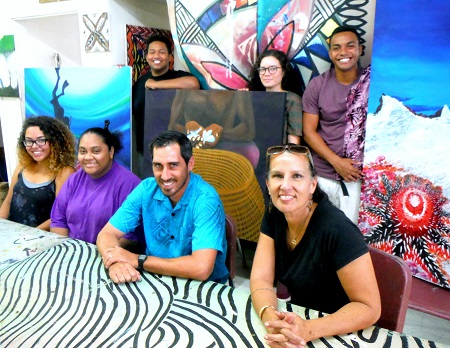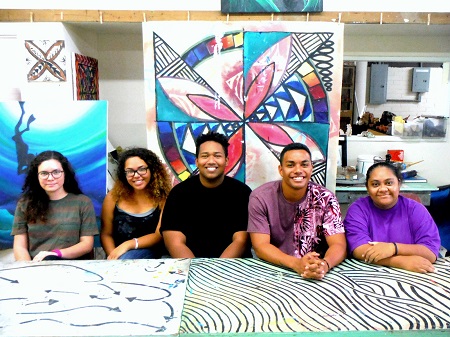
ASCC Art facilitator Ms. Regina Meredith and Marine Science Instructor Jameson Newtson (front, first and second right), along with students in Painting 1 (ART 172), display some of the original artwork created to promote public awareness of the Crown of Thorns Seastar outbreak in American Samoa. The project is a collaboration with the Coral Reef Advisory Group. Also seen here are student artists (front l-r) Pua Tofaeone and Loimata Siona and (back l-r) Manufanua Thomas, Amber Tenniron and Tanumaleu Luani. (Photo: J. Kneubuhl)

These ASCC student artists in the class Painting 1 ART 172), recently produced original works to promote public awareness of the threat to American Samoa's reefs posed by the Crown of Thorns Seastar outbreak. The project is a collaboration with the Coral Reef Advisory Group. The artists are: (l-r) Amber Tennison, Pua Tofaeono, Manufanua Thomas, Tanumaleu Luani and Loimata Siona. (Photo: J. Kneubuhl)

ASCC Art facilitator Ms. Regina Meredith and Marine Science Instructor Jameson Newtson (front, first and second right), along with students in Painting 1 (ART 172), display some of the original artwork created to promote public awareness of the Crown of Thorns Seastar outbreak in American Samoa. The project is a collaboration with the Coral Reef Advisory Group. Also seen here are student artists (front l-r) Pua Tofaeone and Loimata Siona and (back l-r) Manufanua Thomas, Amber Tenniron and Tanumaleu Luani. (Photo: J. Kneubuhl)
ASCC Student Artists Support Coral Reef Awareness
December 7, 2015
By James Kneubuhl, ASCC Press Officer
Student artists in the American Samoa Community College (ASCC) Fine Arts Department class Painting 1 (ART 172) have produced five original artworks as part of a program funded by environmental agency the Coral Reef Advisory Group (CRAG) in an effort to spread awareness of the challenges to local reef health posed by the Crown of Thorns Seastar (COTS) known in Samoan as Alamea. The students, under the guidance of facilitator Regina Meredith, unveiled their work at an informal ceremony held last week.
According to ASCC Marine Science instructor Jameson Newtson, the problems caused to American Samoa’s reefs by Crown of Thorns Seastar have reached a crucial stage. “COTS are a natural part of the ecosystem and can actually encourage coral biodiversity by killing off dominant coral species and allowing other coral species a chance to populate the new area,” he explained. “COTS only become a problem when they reach outbreak levels at over 40 per hectare. Several reefs, including Taema Bank, have been completely destroyed by the COTS outbreak.”
Several agencies working locally, including the National Park Service, the Department of Marine and Wildlife Resources (DMWR), and Marine Sanctuaries, have previously made successful efforts at eradicating COTS, but the numbers keep bouncing back. One hypothesis is that excess nutrients caused from local runoff can cause algal blooms which in turn enhance the survival rate of COTS at the larval stage to subsequent adulthood. Through funding from the National Oceanic and Atmospheric Administration, CRAG has partnered with the ASCC Marine Science and Fine Arts departments to promote community awareness of the COTS threat to our reefs. The artworks by the Fine Arts students are the first in a series of activities that will include the creation of informational brochures, flyers, posters and an infomercial.
The overall project has two distinct components. In addition to the Crown of Thorns Seastar Outbreak Assistance portion, ASCC students will also contribute to A Visual History of Marine Technology in American Samoa, which will involve creating artwork and murals based on historic to modern information, and linking artifacts, island development and Samoan legends. This second segment of the project will utilize the ASPA Archeology Lab's artifacts such as fish hooks, historic fish bones, and fish traps to show the traditional marine technology used for fishing. “Combined with data from both ASPA and the ASCC Samoan Studies Institute, we will incorporate appropriate Samoan legends related to fishing, as well as volcanic activity, island creation, and more,” said Newtson.
To launch the first phase of the project, Newtson outlined its theme, components and parameters to the ASCC Art students, and then let each of them come up with their own creative interpretation. “At the beginning of the semester I met with Ms. Meredith and her painting class to go over the project and talk about the two themes. I brought with me images of COTS, marine scenery, and images of historical Samoan fishing technology. From there, each student decided what to do, and Ms. Meredith overlooked their progress over the course of the semester.”
ART 172 students Amber Tennison, Pua Tofaeono, Manufanua Thomas, Tanumaleu Luani and Loimata Siona each produced a painting which reflected a theme of either the COTS threat or traditional Samoan fishing tools. “We really didn’t know much beforehand about these subjects, so this gave us the opportunity to combine both science and tradition with our artwork,” reflected student Pua Tofaeono. “The idea was for the student artists, to become involved and to spread awareness about local issues,” agreed Newtson. “Taking initiative and being a part of a project like this builds the students’ confidence while at the same time spreading awareness about the local COTS outbreak.”
Newtson said that the new paintings will be displayed first within ASCC, and that he hopes arrangements can be made for their subsequent display at one or more sites off-campus.
